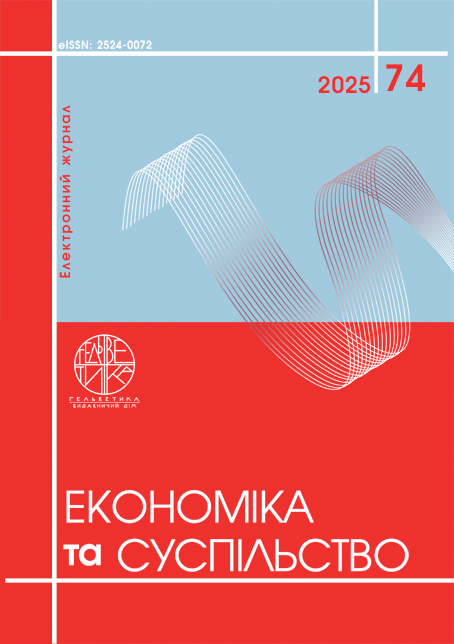DECENTRALIZATION OF ENTERPRISE MANAGEMENT: CLASSIFICATION AND EVALUATION OF ORGANIZATIONAL STRUCTURES
Abstract
The article addresses the pressing issue of determining the degree of susceptibility of organizational structures to decentralization processes in management and substantiates the criteria for selecting a structure oriented toward decentralization principles. This necessity arises from the accelerated changes in the external environment of enterprises amidst economic digitalization, rapid technological advancements, increased speed of information exchange and mobility of resources and people, as well as the growing qualifications of employees. Management decentralization implies the redistribution of authority from top-level executives to lower-level managers, specialists, and workers. It is multidimensional and can be assessed through various parameters, including the direction of dominant communication flows (vertical in centralized and horizontal in decentralized systems), the quantity and significance of decisions made at different levels, and the proportion of resource-related decisions between higher and lower management levels. The purpose of the article is to systematically assess and rank major types of organizational management structures according to their inherent degree of decentralization. Based on an analysis of classifications – particularly those proposed by Henry Mintzberg and the Ukrainian academic tradition – the article distinguishes key structural types: line, line-and-staff, functional, line-functional, divisional, project-based, program-targeted, matrix, network, circular, turquoise, and holacratic. The research reveals that line, line-and-staff, and line-functional structures exhibit a very low degree of decentralization. Professional bureaucracy is also characterized by a low level. The divisional structure demonstrates a moderate level of vertical decentralization, although it may remain highly centralized compared to other firms. High levels of decentralization are noted in functional, project-based, program-targeted, and matrix structures. Very high levels are observed in network, circular, and turquoise structures, which are based on the interaction of autonomous units or self-management. Holacracy demonstrates the maximum level of decentralization, relying on roles, circles, and coordination via clearly defined rules without hierarchy. The study concludes that mechanistic (bureaucratic) structures tend to be more centralized compared to organic (adaptive) ones. Historically, a transition is observed from the dominance of centralized hierarchical structures in the 19th–20th centuries to the spread of organic structures in the latter half of the 20th century and radically decentralized self-management-based approaches in contemporary settings. Investigating the specifics of coordination, goal implementation, and reward systems in such new structures represents a promising direction for future research.
References
Босак А.О., Дарміць Р. З., Босак В. А. Класифікація організаційних структур управління зовнішньоекономічною діяльністю підприємства та умови їх застосування. Вісник Національного університету «Львівська політехніка». 2010. № 691. С. 26–35.
Гуторов О. І., Гуторова О. О. Побудова організації та основні типи організаційних структур управління. Вісник ХНАУ. Серія : Економічні науки. 2018. № 4. С. 185–200.
Зайченко К. С., Дащенко Н. М. Сучасні організаційні структури управління інноваційно-активними малими підприємствами. Економіка. Менеджмент. Бізнес. 2014. № 3. С. 104–110.
Кузьмін, О. Є., Мельник О. Г. Основи менеджменту: підручн. Вид 2-ге, виправ, доп. Київ: Академвидав, 2007. 464 с.
Левчинський Д. Л. Підходи до класифікації організаційних структур управління підприємством. Науковий вісник Міжнародного гуманітарного університету. Серія : Економіка і менеджмент. 2015. Вип. 14. С. 107–110.
Леонов О., Леонова Т. Теорія організації та організаційні структури сучасного корпоративного управління. Економіка та суспільство. 2023. Вип. 54. DOI: https://doi.org/10.32782/2524-0072/2023-54-4.
Менеджмент : навч. посіб. / за заг. ред. К. В. Пічик, В. В. Храпкіної ; Національний університет «Києво-Могилянська академія». Київ: Видавничий дім «Києво-Могилянська академія», 2021. 460 с.
Ситник Й. С. Менеджмент організацій: навчальний посібник. Львів: Тріада-плюс, 2008. 456 с.
Шорохов В. В. Особливості еволюції організаційних структур управління підприємством. Ефективність державного управління. 2015. Вип. 44(2). С. 48–57.
Щербина О. В. Еволюція організаційних структур: сутність, етапи, принципи. Вчені записки : зб. наук. пр. / М-во освіти і науки України, ДВНЗ «Київ. нац. екон. ун-т ім. Вадима Гетьмана». Київ: КНЕУ, 2008. Вип. 10. С. 30–38.
A Guide to the Project Management Body of Knowledge (PMBOK Guide) - Seventh Edition and The Standard for Project Management. Pennsylvania : Project Management Institute, 2021. 274 p.
Bukharina, L., Onyshchenko, O., Bukharina, O. and Zhabytska, N. The importance of implementing an appropriate organizational structure for the development of IT companies in Ukraine. Management and entrepreneurship: trends of development, 2022. Iss.2 (20), pp. 78–88.
Gutterman, A. Organizational Structure: Selecting and Implementing a Structure for Your Business. SSRN Electronic Journal, 2024. 213 p. URL: https://ssrn.com/abstract=4943490 (дата звернення 25.04.2025)
Laloux F. Reinventing Organizations: A Guide to Creating Organizations Inspired by the Next Stage of Human Consciousness. Brussels: Nelson Parker, 2014. 360 p.
Mintzberg H. Structure in fives: Designing effective organizations. Englewood Cliffs, N.J. : Prentice Hall, 1993. 312 p.
Robertson B. Holacracy: The Revolutionary Management System that Abolishes Hierarchy. London: Penguin, UK, 2015. 240 p.
Rychkova I., Zdravkovich J., Speckert T. Challenges of EA Methodologies Facing Progressive Decentralization in Modern Organizations. Proceedings of the 6th International PoEM Conference CEUR-WS.org, 2013. Vol 1023.
Bosak A. O., Darmits R. Z., Bosak V. A. (2010) Klasyfikatsiia orhanizatsiinykh struktur upravlinnia zovnishnoekonomichnoiu diialnistiu pidpryiemstva ta umovy yikh zastosuvannia [Classification of organizational structures for managing the foreign economic activity of an enterprise and the conditions for their application.]. Visnyk Natsionalnoho universytetu «Lvivska politekhnika» – Bulletin of the National University «Lviv Polytechnic». № 691. S. 26–35. (in Ukrainian).
Hutorov O. I., Hutorova O. O. (2018) Pobudova orhanizatsii ta osnovni typy orhanizatsiinykh struktur upravlinnia [Organizational structure and main types of organizational management structures]. Visnyk KhNAU. Seriia : Ekonomichni nauky – Bulletin of the KhNAU. Series: Economic Sciences. № 4. pp. 185–200. (in Ukrainian).
Zaichenko K. S., Dashchenko N. M. (2014) Suchasni orhanizatsiini struktury upravlinnia innovatsiino-aktyvnymy malymy pidpryiemstvamy [Modern organizational structures of management of innovative and active small enterprises.]. Ekonomika. Menedzhment. Biznes. – Economics. Management. Business. 2014. № 3. S. 104–110. (in Ukrainian).
Kuzmin, O. E., Melnyk, O. G. (2007) Fundamentals of Management: Textbook. 2nd edition, corrections, additions. Kyiv: Akademvydav. 464 p. (in Ukrainian).
Levchynskyi D. L. (2015) Pidkhody do klasyfikatsii orhanizatsiinykh struktur upravlinnia pidpryiemstvom [Approaches to the classification of organizational structures of enterprise management]. Naukovyi visnyk Mizhnarodnoho humanitarnoho universytetu. Seriia : Ekonomika i menedzhment – Scientific Bulletin of the International Humanitarian University. Series: Economics and Management. Vol. 14. pp. 107–110. (in Ukrainian).
Leonov, O., & Leonova, T. (2023). Teoriia orhanizatsii ta orhanizatsiini struktury suchasnoho korporatyvnoho upravlinnia [Organization theory and organizational structures of modern corporate management]. Ekonomika ta suspilstvo – Economy and Society, (54). https://doi.org/10.32782/2524-0072/2023-54-4 (in Ukrainian).
Menedzhment : navch. posib. (2021) [Management] / za zah. red. K. V. Pichyk, V. V. Khrapkinoi; Natsionalnyi universytet «Kyievo-Mohylianska akademiia». Kyiv: Vydavnychyi dim «Kyievo-Mohylianska akademiia». 460 p. (in Ukrainian).
Sytnyk Y. S. (2008) Menedzhment orhanizatsii: navchalnyi posibnyk [Organizational Management: A Study Guide]. Lviv: Triada-plius, 2008. 456 s. (in Ukrainian).
Shorokhov V. V. (2015) Osoblyvosti evoliutsii orhanizatsiinykh struktur upravlinnia pidpryiemstvom [Features of the evolution of organizational structures of enterprise management]. Efektyvnist derzhavnoho upravlinnia – Efficiency of public administration. Vol. 44(2). pp. 48–57. (in Ukrainian).
Shcherbyna O. V. Evoliutsiia orhanizatsiinykh struktur: sutnist, etapy, pryntsypy [Evolution of organizational structures: essence, stages, principles]. Vcheni zapysky : zb. nauk. pr. / M-vo osvity i nauky Ukrainy, DVNZ «Kyiv. nats. ekon. un-t im. Vadyma Hetmana» – Scholarly notes. Kyiv: KNEU, 2008. Vol. 10. pp. 30–38. (in Ukrainian).
A Guide to the Project Management Body of Knowledge (PMBOK Guide) - Seventh Edition and The Standard for Project Management (2021). Pennsylvania : Project Management Institute, 274p.
Bukharina, L., Onyshchenko, O., Bukharina, O. and Zhabytska, N. (2022) The importance of implementing an appropriate organizational structure for the development of IT companies in Ukraine. Management and entrepreneurship: trends of development, 2022. Iss.2 (20), pp. 78–88.
Gutterman, A. (2024) Organizational Structure: Selecting and Implementing a Structure for Your Business. SSRN Electronic Journal, 2024. 213 p. URL: https://ssrn.com/abstract=4943490.
Laloux F. (2014) Reinventing Organizations: A Guide to Creating Organizations Inspired by the Next Stage of Human Consciousness. Brussels: Nelson Parker, 360 p.
Mintzberg H. (1993) Structure in fives: Designing effective organizations. Englewood Cliffs, N.J. : Prentice Hall, 312p.
Robertson B. (2015) Holacracy: The Revolutionary Management System that Abolishes Hierarchy. London: Penguin, UK, 240 p.
Rychkova I., Zdravkovich J., Speckert T. (2013) Challenges of EA Methodologies Facing Progressive Decentralization in Modern Organizations. Proceedings of the 6th International PoEM Conference CEUR-WS.org., Vol 1023.

This work is licensed under a Creative Commons Attribution 4.0 International License.


